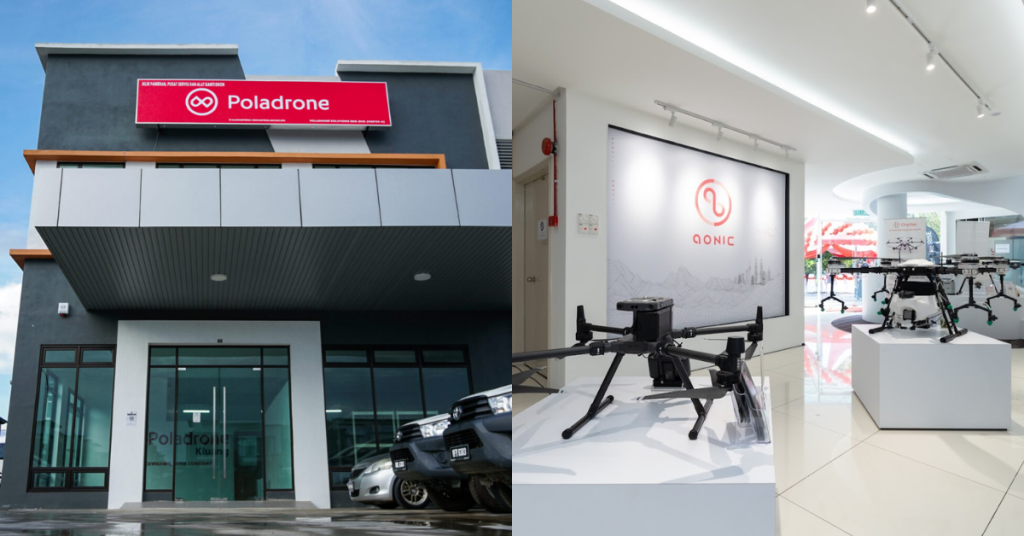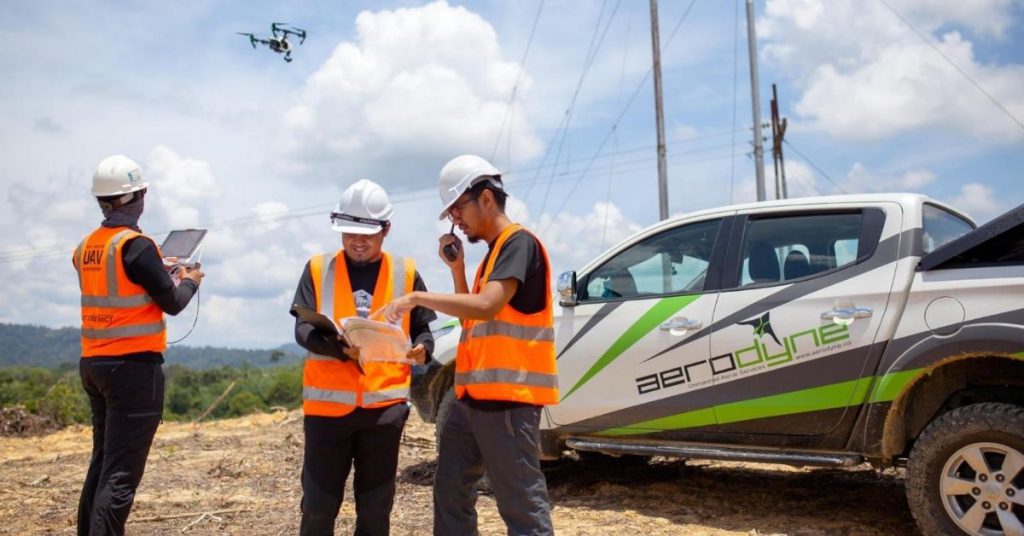When you think of the top drone startups in Malaysia, it’s impossible not to mention Aerodyne and Aonic.
The two startups’ founders shared the stage during the recent Tech in Asia conference in KL for a panel titled “Pivoting on the Drone Tech Journey”.
From Aerodyne, there’s Kamarulazman Muhamed (who goes by Kamarul), the founder and group CEO. Meanwhile, Jin Xi Cheong (who goes by JX) is the founder and CEO of Aonic, which some might remember as Poladrone back in the day.
Moderated by ScaleUp Malaysia’s Aaron Sarma, the two dronetech juggernauts shared that this might be one of the first times they were featured in a panel together. Here’s a little backstory on who they are, and how they’ve grown.

Get to know them
Founded in 2014, Aerodyne is a DT3 enterprise solutions provider using drone data and AI-powered analytics. DT3 stands for dronetech, data tech, and digital transformation.
Aerodyne is actually Kamarul’s fourth startup, with him having exited the last three. The last was a media company that had a drone division. At the time, drones were primarily used for visual solutions, but in 2014, he realised there was a greater potential in the sector.
It started with project monitoring solutions, growing from just one site to eventually 50. In just two years, the team grew from three people to 200.
Meanwhile, Aonic was founded in 2016. As mentioned, it was formerly known as Poladrone, which is a portmanteau of Polaroid and drones, signifying the startup’s past focus on visuals-based solutions.

JX shared that he’d been playing around with drones since he was quite young. Spending some time in Australia, he noticed how strong the drone racing culture there was.
After pursuing aerospace engineering in Australia, he worked at Intel for some years, where one project involved using drones. It was then that he saw a big gap in the understanding of drones in the region as well as with the technical capabilities of drone users.
That was the spark to form Poladrone. From there, he started venturing into industrial applications, eventually carving out a space in the agriculture scene, allowing farmers to operate cutting-edge technology.
Full of pivots
Rather than think of themselves as primarily drone companies, though, the two startups actually consider themselves to be a data company first.
Kamarul said that data is at the core of what Aerodyne does. “In fact, I have more than 150 data engineers and AI scientists,” he said.
As JX said, if you think about a drone, it’s just a flying camera in the sky. What’s valuable is the data that it captures.
The Aonic CEO also said that unless they’re a manufacturer, drone startups who don’t hone in on data are probably not around anymore.
Both companies made this realisation that they had to be bigger than just drone services some years ago.
For Aerodyne, Kamarul said that a motivating factor for the business back in 2014 was a report from PwC that stated the drone industry was set to be worth around US$128 billion.
So, he made the pivot from his media company. But then, he said that the figure was honestly far from the truth, and that by 2020 it wasn’t even 25% of the projected market size.
But he said that earlier in 2017, he already realised that it wasn’t about flying drones—it’s really about the data. From there, they began working with clients like TNB to leverage drones to provide solutions.
And now, with the advent of AI, the latest pivot is to focus on AI tech. Kamarul even talked about the development of an enterprise LLM (large language model) that would allow for a sort of “Uber-isation” of dronetech.

Aonic realised the shift in about 2018 and 2019. When Poladrone first launched, the objective was to make drones accessible to all with a focus on mapping services. After some years, though, they realised they couldn’t scale. One reason was because as a service provider, they were overly reliant on operations and people.
Thus, they decided to approach the industry in a different way, going from service provider to solutions provider.
This means that they would shift their focus to not just offer services to clients, but enable them to do it themselves. This was a scary juncture, of course.
“Essentially, you’re teaching the customer to fish themselves,” JX pointed out. However, they knew that drones were still very technical, involving a large volume of data. So, there were still a lot of value-added services that they could provide clients.
This pivot allowed them to scale quickly, and they’ve grown the team from 20 to 250 since 2019.
Putting Malaysia on the map
However, the market for drone services is not big enough in Malaysia, Kamarul said. Thus, to truly scale, you must go beyond.
The way that Aerodyne approached global expansion was through strategic M&As (mergers and acquisitions). They would look for top companies in the region, then invest and take a controlling stake in the company. But why would those companies want to sell?
Well, Kamarul said that the results speak for themselves. When Aerodyne invests, revenues go up.

However, for Aonic, given that they have more limited funds, expanding by way of M&As would not be plausible.
Instead, they had to rely on more grassroots effort, expanding into other countries through a structured and slow approach.
Moving forward, Aonic aims to further focus on the agriculture sector and build a whole ecosystem that exists beyond dronetech. Going downstream, they’re even looking at selling fertiliser and seeds, as well as helping finance founders.
As for Aerodyne, they’ve grown from serving companies to enterprises, and now, they aim to solve national problems. That may be in agriculture or perhaps logistics.
Another one is education. Today, there’s already the Aerodyne Flight Institute. But Kamarul shared that they want to start a university to build the right talent pool in Malaysia.
Aonic and Aerodyne undoubtedly have contributed a lot towards putting Malaysia on the map when it comes to dronetech. And with JX and Kamarul’s ambitious plans, it seems like they are intent on keeping us there.
- Learn more about Aerodyne here.
- Learn more about Aonic here.
- Read other articles we’ve written about drones here.
Featured Image Credit: Vulcan Post

